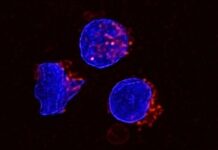A team of researchers associated with Allahabad University (AU) has developed a novel nano drug that shows promising potential in treating tuberculosis (TB) and inflammation simultaneously. This groundbreaking innovation uses nanoparticles of gold (Au), platinum (Pt), and copper (Cu) to deliver targeted treatment with enhanced efficacy.
Published in a Leading International Journal
The findings were recently published in the internationally reputed journal Future Medicinal Chemistry by Taylor & Francis (UK). The study highlights how the unique combination of the three metals creates a multi-functional nanofluid capable of attacking two of the most challenging health threats—TB and inflammation—at once.
Laboratory and Computational Confirmation
As reported by TOI, the team conducted extensive testing not only in the laboratory but also using advanced computational techniques. According to Amit Dubey, an AU alumnus and one of the lead researchers, molecular docking revealed that the nanofluid binds strongly with TB bacteria, while molecular dynamics simulations confirmed that this bond remains stable over time.
“This dual confirmation reinforces the drug’s potential to function effectively inside the human body,” said Dubey.
Multidisciplinary Team Behind the Breakthrough
The development is the result of a collaborative effort by a multidisciplinary team that includes Amit Dubey, Manish Kumar from Iswar Saran Degree College, Aisha Tufail from AU, and Abhay Bagul from Pune’s Forensic Science Laboratory. The researchers combined hands-on experimentation with computational biology to understand the molecular behavior of the nanodrug.
A Powerful Multi-Targeted Therapy
Dubey explained that the nanofluid works by targeting multiple sites simultaneously, which gives it an edge over conventional medicines. “Traditional drugs often focus on a single target, but our nanodrug attacks multiple disease mechanisms, making it significantly more potent,” he said.
Addressing India’s Dual Disease Burden
India continues to report over 24 lakh new TB cases annually, making it the country with the highest TB burden globally. At the same time, the prevalence of chronic inflammatory conditions is on the rise. This dual-targeted nano drug could offer low-cost, high-efficiency treatment options with fewer side effects.
Next Steps: Towards Human Trials
The team now plans to begin in-vivo testing and move toward structural optimization, preparing for potential clinical applications. “Our mission is simple yet bold—to develop a nanomedicine that doesn’t just treat but transforms lives,” said Dubey.
If successful, this India-origin innovation could usher in a new era of precision nanomedicine, offering powerful solutions for complex diseases with minimal toxicity and maximum impact.
























